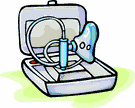 It improves quality of life even in patients with less-advanced cases of chronic obstructive pulmonary disease (COPD).
It improves quality of life even in patients with less-advanced cases of chronic obstructive pulmonary disease (COPD).
Researchers from Maastricht University Medical Center, in the Netherlands reported their results during the annual meeting of the American Thoracic Society.
First, the details.
- 199 newly diagnosed patients with moderate COPD — defined as a one-second forced expiratory volume (FEV1) of 60% of predicted values — were randomly assigned to usual care or to the rehab program.
- Rehab included 4 months of exercise training, smoking cessation, nutritional advice, and other support, followed by 20 months of maintenance.
- FEV1 measures lung capacity.
- Differences in quality of life (St. George’s Respiratory Questionnaire), shortness of breath (measured on the Medical Research Council five-point scale), and exercise capacity as tested by endurance on a stationary bicycle were measured.
And, the results.
- 4-point significant improvement on the quality of life scale after 4 months.
- After 2 years, the difference was a significant 2.6 points.
- 4-minute improvement in cycle endurance time.
- This improved to 6 minutes after 2 years, because of the continuing decline in the usual care group.
- 0.33-point significant improvement in shortness of breath at 4 months.
- At 2 years, the difference was a significant 0.21 points.
- Both patients and caregivers perceived that the benefits of pulmonary rehabilitation were significant.
- Over 2 years, the cost of the program was about $3,700 higher vs usual care.
The bottom line?
The researchers commented that it’s unusual to be able to show a 4-point improvement on the St. George’s scale. “It’s tremendously difficult in these patients.”
A one-third of a point improvement on the Medical Research Council scale is also “pretty good.”
The American Thoracic Society has a succinct review of pulmonary rehabilitation.
5/25/09 12:03 JR